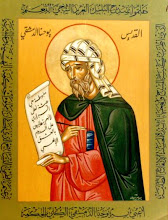Ever since it was built by the Byzantine Emperor Constantine in 335 on the hill of Golgotha, where his mother, Helena, claimed to have found the remains of the True Cross, the Church of the Holy Sepulcher in Jerusalem's Old City has enjoyed little peace. The historian Eusebius records that the original structure, "an extraordinary work," was crowned by a roof "overlaid throughout with radiant gold." But Constantine's marvel was razed by the Persians in 614, reconstructed, and then destroyed again by Caliph Hakim of Egypt in 1009. Rebuilt by Crusaders in the 11th and 12th centuries, the building evolved into the motley collection of shrines, chapels and grottos that greet--and sometimes disappoint--the visitor today. The critic Edmund Wilson said it "probably contains more bad taste, certainly more kinds of bad taste, than any other church in the world."For entire article, click here.
....
In 1757, after Greek Orthodox clergy violently wrested majority control of the church from the Roman Catholics, the Ottoman rulers of Jerusalem decreed a status quo for the city's holy sites. For the Church of the Holy Sepulcher, this meant that control was split primarily among the three patriarchates of Jerusalem--the Latin, the Greek and the Armenian--and secondarily among the churches of Egypt (Coptic), Syria and Ethiopia. The arrangement, formalized in 1852, has been enforced by the British, Jordanians and, today, Israel.
...
The turf wars also paralyze maintenance. A wooden ladder has rested on a ledge over the church's entrance for at least 150 years. The edicule, braced with scaffolding, is falling apart. The Chapel of St. Nicodemus, over which both the Armenians and the Syrians claim ownership, has for that reason never been restored. To prevent denominational disputes, the very keys to the church have since the days of Saladin been entrusted to Muslims from the Nuseibeh and Joudeh families.
Friday, July 27, 2007
Wall Street Journal on the Church in Jerusalem
The Wall Street Journal features an article by Benjamin Balint on the Church of the Holy Sepulchre. Below are a few excerpts.
Subscribe to:
Post Comments (Atom)


No comments:
Post a Comment